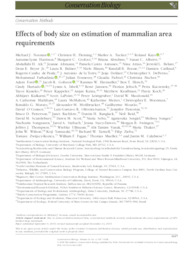Effects of body size on estimation of mammalian area requirements.
Effects of body size on estimation of mammalian area requirements.
Author(s): NOONAN, M. J.; FLEMING, C. H.; TUCKER, M. A.; KAYS, R.; HARRISON, AUTUMN-LYNN; CROFOOT, M. C.; ABRAHMS, B.; ALBERTS, S.; ALI, A. H.; ALTMANN, J.; ANTUNES, P. C.; ATTIAS, N.; BELANT, J. L.; BEYER JUNIOR, D. E.; BIDNER, L. R.; BLAUM, N.; BOONE, R. B.; CAILLAUD, D.; PAULA, R. C. de; DE LA TORRE, J. A.; DEKKER, J.; DEPERNO, C. S.; FARHADINIA, M.; FENNESSY, J.; FICHTEL, C.; FISCHER, C.; FORD, A.; GOHEEN, J. R.; HAVMØLLER, R. W.; HIRSCH, B. T.; HURTADO, C.; ISBELL, L. A.; JANSSEN, R.; JELTSCH, F.; KACZENSKY, P.; KANEKO, Y.; KAPPELER, P.; KATNA, A.; KAUFFMAN, M.; KOCH, F.; KULKARNI, A; LAPOINT, S.; LEIMGRUBER, P.; MACDONALD, D. W.; MARKHAM, A. C.; MCMAHON, L.; MERTES, K.; MOORMAN, C. E.; MORATO, R. G.; MOßBRUCKER, A. M.; MOURAO, G.; O'CONNOR, D.; OLIVEIRA-SANTOS, L. G. R.; PASTORINI, J.; PATTERSON, B. D.; RACHLOW, J.; RANGLACK, D. H.; REID, N.; SCANTLEBURY, D. M.; SCOTT, D. M.; SELVA, N.; SERGIEL, A.; SONGER, M.; SONGSASEN, N.; STABACH, J. A.; STACY-DAWES, J.; SWINGEN, M. B.; THOMPSON, J. J.; ULLMANN, W.; VANAK, A. T.; THAKER, M.; WILSON, J. W.; YAMAZAKI, K.; YARNELL, R. W.; ZIEBA, F.; ZWIJACZ-KOZICA, T.; FAGAN, W. F.; MUELLER, T.; CALABRESE, J. M.
Summary: Accurately quantifying species' area requirements is a prerequisite for effective area-based conservation. This typically involves collecting tracking data on species of interest and then conducting home range analyses. Problematically, autocorrelation in tracking data can result in space needs being severely underestimated. Based on the previous work, we hypothesized the magnitude of underestimation varies with body mass, a relationship that could have serious conservation implications. To evaluate this hypothesis for terrestrial mammals, we estimated home-range areas with global positioning system (GPS) locations from 757 individuals across 61 globally distributed mammalian species with body masses ranging from 0.4 to 4000 kg. We then applied blockcross validation to quantify bias in empirical home range estimates. Area requirements of mammals < 10 kg were underestimated by a mean approximately 15%, and species weighing approximately 100 kg were underestimatedby approximately 50% on average. Thus, we found area estimation was subject to autocorrelation induced bias that was worse for large species. Combined with the fact that extinction risk increases as body mass increases, theallometric scaling of bias we observed suggests the most threatened species are also likely to be those with theleast accurate home range estimates. As a correction, we tested whether data thinning or autocorrelation informedhome range estimation minimized the scaling effect of autocorrelation on area estimates. Data thinning requiredan approximately 93% data loss to achieve statistical independence with 95% confidence and was, therefore, nota viable solution. In contrast, autocorrelation informed home range estimation resulted in consistently accurateestimates irrespective of mass. When relating body mass to home range size, we detected that correcting forautocorrelation resulted in a scaling exponent significantly >1, meaning the scaling of the relationship changedsubstantially at the upper end of the mass spectrum.
Publication year: 2020
Types of publication: Journal article
Unit: Embrapa Pantanal
Observation
Some of Embrapa's publications are published as ePub files. To read them, use or download one of the following free software options to your computer or mobile device. Android: Google Play Books; IOS: iBooks; Windows and Linux: Calibre.
Access other publications
Access the Agricultural Research Database (BDPA) to consult Embrapa's full library collection and records.
Visit Embrapa Bookstore to purchase books and other publications sold by Embrapa.

